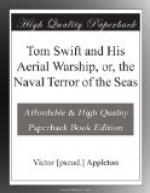“I understand,” Tom answered. “And I am going to begin work on mounting the guns at once. I am going to use the Newton recoil check,” he added. “Ned, here, is responsible for that.”
“Is that so?” asked the lieutenant, as Tom clapped his chum on the back.
“Yes, that’s his invention.”
“Oh, it isn’t anything of the sort,” Ned objected. “I just—”
“Yes, he just happened to solve the problem for me!” interrupted Tom, as he told the story of the door-spring.
“A good idea!” commented Lieutenant Marbury.
Tom then briefly described the principle on which his aerial warship would work, explaining how the lifting gas would raise it, with its load of crew, guns and explosives, high into the air; how it could then be sent ahead, backward, to either side, or around in a circle, by means of the propellers and the rudders, and how it could be raised or lowered, either by rudders or by forcing more gas into the lifting bags, or by letting some of the vapor out.
And, while this was being done by the pilot or captain in charge, the crew could be manning the guns with which hostile airships would be attacked, and bombs dropped on the forts or battleships of the enemy.
“It seems very complete,” observed the lieutenant. “I shall be glad when I can give it an official test.”
“Which ought to be in about a week,” Tom said. “Meanwhile I shall be glad if you will be my guest here.”
And so that was arranged.
Leaving Ned and the lieutenant to entertain each other, Tom went to see the mechanics who had applied for places. He found them satisfactory and engaged them. One of them had worked for him before. The other was a stranger, but he had been employed in a large aeroplane factory, and brought good recommendations.
There followed busy days at the Swift plant, and work was pushed on the aerial warship. The hardest task was the mounting of the guns, and equipping them with the recoil check, without which it would be impossible to fire them with the craft sailing through the air.
But finally one of the big guns, and two of the smaller ones were in place, with the apparatus designed to reduce the recoil shock, and then Tom decided to have a test of the Mars.
“Up in the air, do you mean?” asked Ned, who was spending all his spare time with his chum.
“Well, a little way up in the air, at least,” Tom answered. “I’ll make a sort of captive balloon of my craft, and see how she behaves. I don’t want to take too many chances with that new recoil check, though it seems to work perfectly in theory.”
The day came when, for the first time, the Mars was to come out of the big shed where she had been constructed. The craft was not completed for a flight as yet, but could be made so in a few days, with rush work. The roof of the great shed slid back, and the big envelope containing the buoyant gas rose slowly upward. There was a cry of surprise from the many workmen in the yard, as they saw, most of them for the first time, the wonderful new craft. It did not go up very high, being held in place with anchor ropes.




